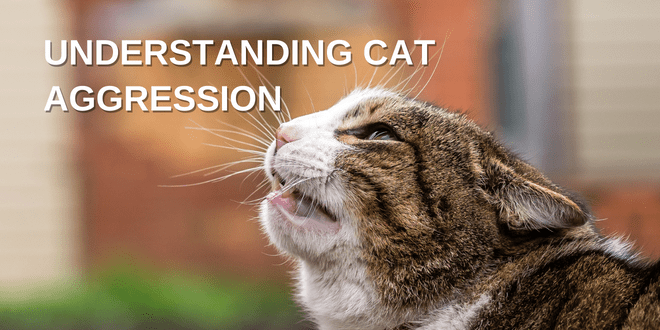
When it comes to having an actual physical altercation, cats do everything they can to try to avoid it. The cat who feels backed in a corner with no other option is the one who will engage in a tooth and nail battle. In general, a cat’s first choice is to either take the escape route, or look intimidating enough that the opponent will back down. Being in the position of being both predator and prey, means cats have to be good at determining whether the best course of action is to engage in battle or escape.
There are many types of aggression. To understand the behavior requires identifying the underlying cause so an appropriate behavior plan can be put into action. A cat can exhibit aggressive behavior for many reasons and in order to safely and effectively address it, you have to identify why it’s being displayed. Aggression can be serious and challenging to identify the cause. What’s most important as the problem is being addressed is the safety of everyone in the family.
Here are just some of the types of aggression that cats may display.
Some common aggression types:
Fear aggression. Basically, all aggression is rooted in fear. The cat feels threatened for frightened. The cat may be fearful of something unknown or unfamiliar. A cat may also exhibit fear aggression in a setting such as the veterinary clinic. The best way to handle this type of aggression is to do your best to avoid putting the cat in a position where he is faced with unfamiliar or threatening objects. If that can’t be avoided, use gradual desensitization to help him become more comfortable. For example, if your cat is afraid of the carrier and displays aggression when it’s brought out, leave the carrier out all the time so it starts to be viewed as just a neutral part of the environment. Periodically toss treats near it and eventually inside. Clicker training works very well with cats who demonstrate fear aggression.
Petting-Induced aggression. The cat is being stroked and then for some reason will suddenly lash out aggressively. The cause could be hard to identify. For some cats, petting becomes too stimulating, or the cat may have reached his tolerance limit. The cat parent may have started petting in a sensitive area and was not aware of the changes to the cat’s reaction. To help a cat who displays this type of aggression, you need to pay close attention when you’re petting so you can watch for initial signs indicating the cat is starting to not enjoy it. Also, stick to areas of the body that you know your cat prefers. Shorten the amount of time you pet so you leave your cat wanting more rather than pushing him to his limit. Over time, you may be able to gradually increase the amount of petting.
Territorial aggression. When a cat feels his territory is being threatened, this type of aggression may be displayed. Cat parents commonly see this during new cat introductions. The key to avoid making territorial aggression worse is to do gradual and positive new cat introductions. Don’t rush the process and focus on giving the cats a reason to like each other. Don’t just put the cats together. Place the newcomer in a sanctuary room and take the introduction one step at a time. You can find detailed instructions in my book, Cat vs Cat.
Redirected aggression. This occurs when a cat is aroused by something and is unable to access the source of his agitation, so he may lash out at the nearest cat, dog, or person. This is a common type of aggression that can occur between companion cats when one cat sees something outside the window, such as an unfamiliar cat in the yard. If you know you have a cat who is susceptible to redirected aggression, do what you can to limit his exposure to triggering stimuli. If the problem is a cat in the yard, block viewing access at that window and create an appealing set-up at a window where the outdoor cat won’t be seen.
Play aggression. This is seen in cats who have been allowed to play too rough or if cat parents have used their hands as toys. Also, if cat parents have played by wrestling with their cats. Kittens who didn’t spend adequate time with littermates may exhibit play aggression. To address this, pay attention to signs that it’s about to start so you can distract the cat with a toy. Always use a wand type or fishing pole type toy so there’s a distance between your hands and the cat’s teeth. Engage in interactive play sessions several times a day so the cat can work off energy and also learn what objects are appropriate for biting.
Non-recognition aggression. A common example of this is when one cat in a multicat household returns from the veterinary clinic and is attacked by the other resident cat(s). The cat who remained home doesn’t recognize the scent of the returning cat as familiar. In addition, the scent that’s on the returning cat is one that is associated with fear. To address this behavior, put the returning cat in a separate room immediately upon coming home so he can take on the normal scents of the environment. This will also give him time to groom himself. Wash the carrier as well because that will have the scents from the veterinary clinic.
Pain-induced aggression. A cat may react defensively when handled if in pain, or if a procedure done to the cat triggers pain. This is often seen in older cats who have arthritis and react aggressively when handled. Pay attention when petting, picking up or holding your cat if you know there are areas of the body that are painful, so you don’t inflict further pain or discomfort. Your veterinarian may also advise a pain management plan for your cat
Maternal aggression. A mother cat will show aggression if she feels the safety of kittens is at risk. To avoid triggering this behavior, make sure the mother feels secure and don’t interfere when she’s tending to her kittens. Keep other pets in the home away from her and the kittens so she can nurse them without worry. Provide the mother and kittens with a quiet place and don’t interact if she starts to show signs of aggressive behavior. As the kittens start to grow, the mother will be less inclined to display aggressive behavior.
Intercat aggression. This is also sometimes referred to as inter-male aggression, although females display it as well. Cats will engage in aggressive behavior toward each other. It can happen as the cats reach social maturity at two years of age. It can also be due to territorial disputes. If the cats are intact, then it’s important to get them neutered or spayed to reduce the hormone influence. Make sure each cat has adequate resource availability and personal core areas. Intercat aggression can be intensified by having to compete for resources. In some cases, the cats need to be separated and a reintroduction done.
Status-related aggression. This occurs when one cat takes a position of assuming dominance over others in the home. The cat may engage in direct staring, blocking, and may only accept affection when he initiates it. Status-related aggression may be directed toward all the animals or family members in the home or just toward select ones. Typically, the best way to address this is to ignore the cat when he’s showing dominance and then reward and give attention when he displays a relaxed behavior.
Here are some body language signals:
Ear position flattened or pinned back. This is a protection position for the ears and indicates the cat is ready to defend himself.
Crouching. Commonly seen with fear aggression. The cat will crouch low to the ground and wrap his tail around his body or tuck it underneath. The cat will usually hiss and growl.
Hissing and growling. Hissing is a defensive vocalization. The cat is scared. Hissing is often accompanied by growling.
Baring of teeth. The face is very tight, teeth are bared and there’s usually hissing and growling.
Spitting. This is a sound made by a cat who is startled and frightened.
Arched back. This is commonly referred to as the Halloween cat position. The cat stands on tip-toes and arches his back to look as big and threatening as possible. This is a defensive posture. The arched back will have piloerection of haircoat. The tail will resemble a bottle brush.
Swatting with or without claws unsheathed. When the cat isn’t sure if there’s an escape, he may give a warning swipe to the opponent. If claws are extended then aggression has elevated.
Tail lashing or thumping. Tail lashing or thumping are typically an indication of irritation. You have to pay attention to the context of the environment though because a cat will often swish his tail when excited while watching prey.
Stalking. An offensive behavior, the cat will walk toward the target with head lowered, while making direct eye contact. This posture is usually accompanied by growling.
Blocking. This one can be easy to misinterpret because the cat may look as if he’s lounging but what he may actually be doing is blocking access to something such as a resource (feeding station, litter box, etc.).
Biting. It may be an inhibited bite given as a warning or it could be a full bite. You have to take the circumstances into consideration when evaluating whether it’s aggression. A cat may have learned to bite in play if cat parents use fingers as toys. A cat may also bite for attention because that has always gotten a response in the past.
Don’t Just Label a Cat as Aggressive
A cat may display aggressive behavior in particular circumstances but that doesn’t mean he’s an aggressive cat. People are often too quick to label a cat as “aggressive” when in reality, the cat may merely be feeling as if all escape has been cut off or body posture signals have failed. Cats shouldn’t be labeled as aggressive. Cats may display aggression based on a specific circumstance. If that circumstance doesn’t change, the cat may display aggression repeatedly. Often, the reason human family members get bitten by the cat is because they either misinterpreted the cat’s body language or chose to ignore the clear signals being sent out.
The aggressive behavior a cat displays is usually due to fear and the fact that he feels threatened. It may be that he’s afraid he’s going to get hurt or restrained, or maybe he thinks his resources are in danger (such as his food). He may feel a territorial threat by an unfamiliar cat or a stranger in the environment. In the case of maternal aggression, the mother feels there’s a threat to her kittens. When it comes to pain, a family member may try to pick up the cat or pet him without realizing that he is hurting so the cat lashes out.
How to Deal With Cat Aggression
Veterinarian visit. Aggression can be the result of an underlying medical problem and that’s the first place you should start. Your cat should be examined by the veterinarian whenever there is a change in behavior. Even if you’re convinced the problem is behavioral, it’s important to rule out medical causes because your cat may be suffering.
Positive, reward-based training. In terms of behavior, the best way to deal with the aggression is to change the circumstances as best as you can so the cat doesn’t feel threatened. Since aggression can be scary for cat parents to deal with, and can be dangerous to both humans and cats, If kitty gets a clean bill of health your veterinarian may offer a referral to a certified behavior expert. If you do decide to seek professional help, be sure you choose someone who is certified in cat behavior. There are many people on the internet who claim to be behavior experts but if they aren’t certified, you have no way of knowing if the information they provide will be helpful or harmful. When it comes to dealing with an aggression problem, the wrong advice can have disastrous consequences.
Be a detective. Be aware of behavior triggers or cues that cause your cat to become reactive. This is where you need to be a detective to figure out the underlying cause. Is your cat reacting to a new cat in the home? Or maybe he’s seeing an unfamiliar cat in the yard? There are numerous possibilities, so take time to uncover what is triggering your cat. Does your cat feel threatened when eating? Or are guests in your home approaching your cat too quickly? Is your senior cat experiencing cognitive issues that are causing the aggression? Identify the underlying cause. Once you determine the cause, alter the circumstances to allow your cat to feel less threatened. Make sure your cat has choices so he feels he has security, places to retreat, and is in control of whether to engage or avoid. Offering choice is a powerful behavior tool for turning the volume down on fear.
Be patient. Never punish your cat for aggressive displays as that will only intensify fear and will be counter-productive to any training attempts. A cat doesn’t display aggression to be mean. An aggressive display means the cat feels threatened, hurt, or afraid. Use behavior techniques that increase security, choice, and comfort.
Professional help. Remember, there are professional behavior experts available to help you figure out why your cat is displaying the behavior. Aggression is scary and it’s important to work in a way that doesn’t cause risk of injury to any family members or the cat himself. Your veterinarian can refer you to a behavior expert if needed. Also, in some cases, medication may be helpful while working through the behavior techniques. Your veterinarian or a veterinary behaviorist can guide you there.
Need More Information?
For more information on cat behavior, refer to the best-selling books by Pam Johnson-Bennett. Pam’s books are available at bookstores and online. We’ve included Amazon links here on our website.
If you have a question regarding your cat’s health, please contact your veterinarian. This article is not intended as a replacement for your cat’s veterinary care. This article is for information purposes only and not offering medical advice or providing a medical diagnosis.
 Problem Solving & Advice by Pam Johnson-Bennett Cat Behavior Expert & Best-selling Author
Problem Solving & Advice by Pam Johnson-Bennett Cat Behavior Expert & Best-selling Author




